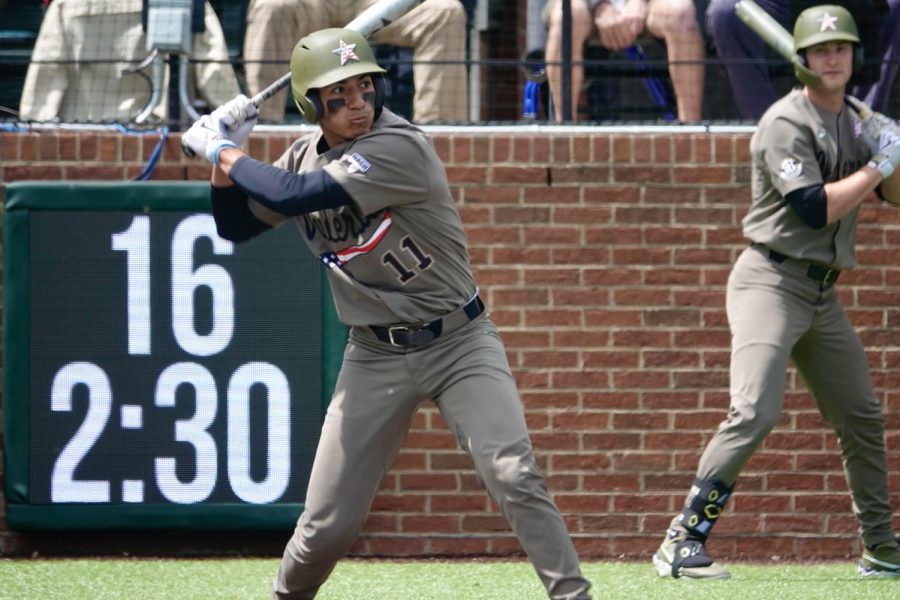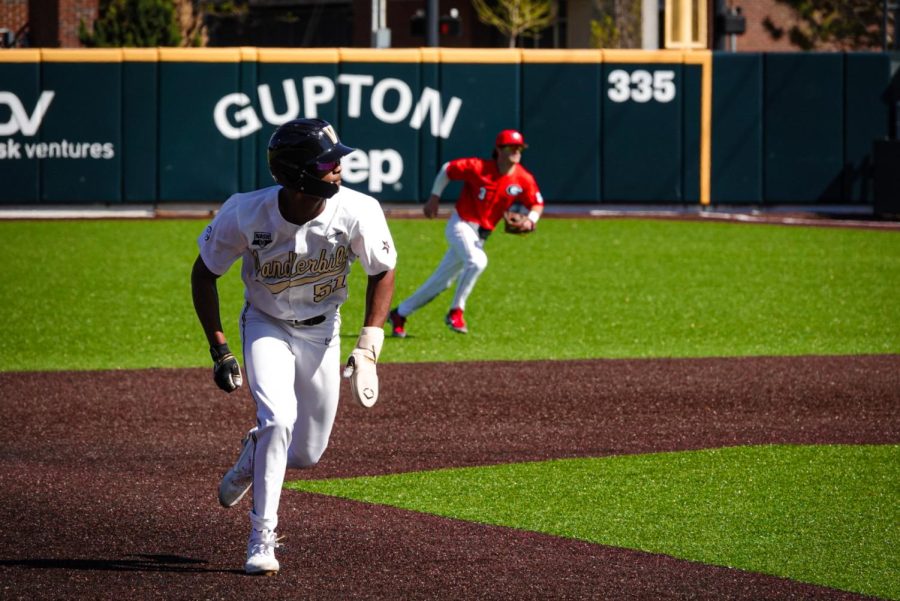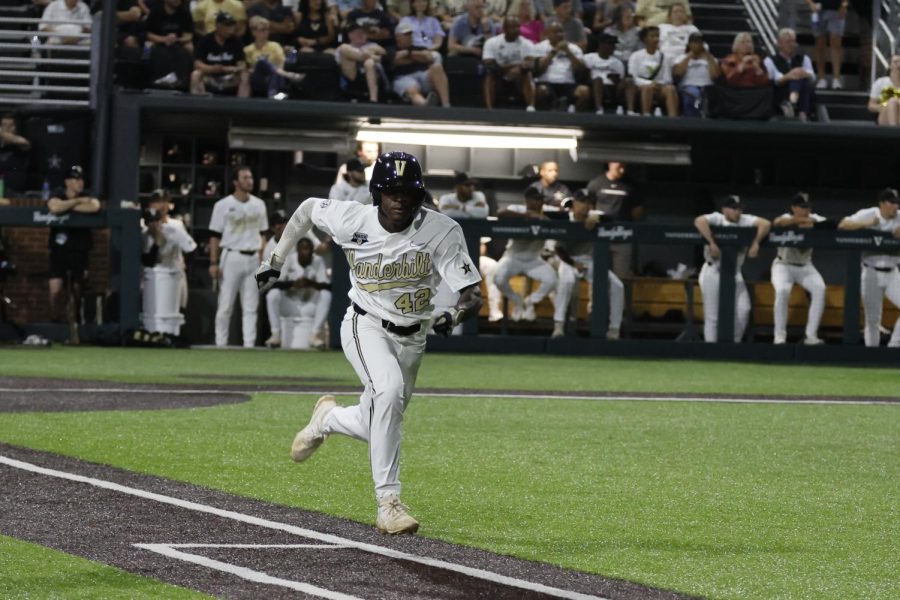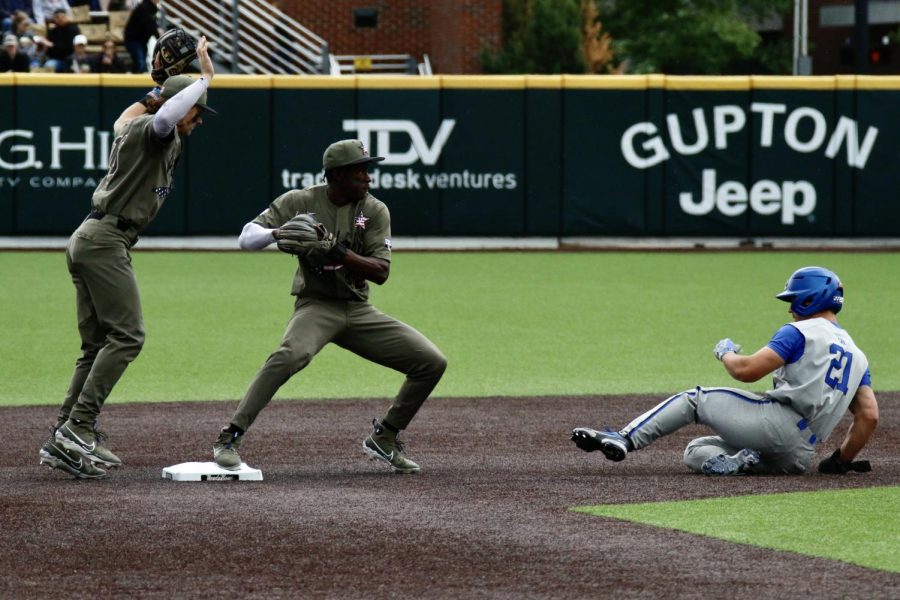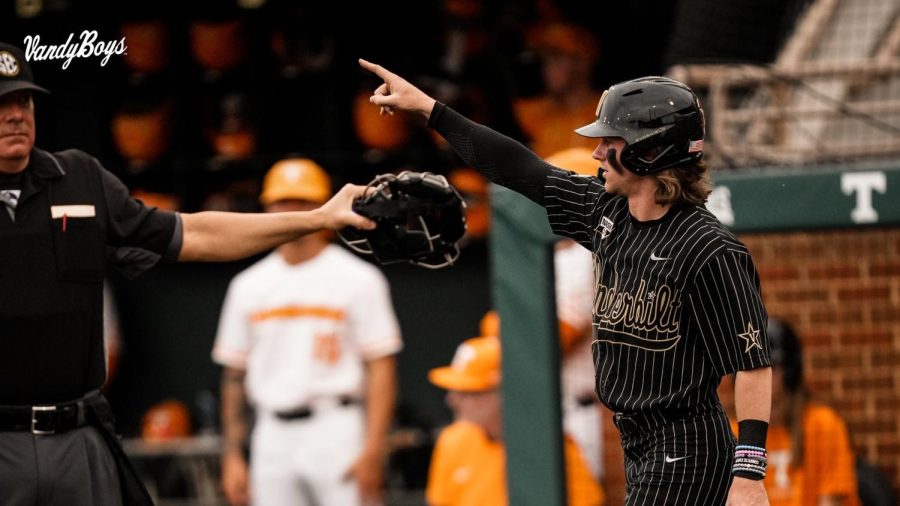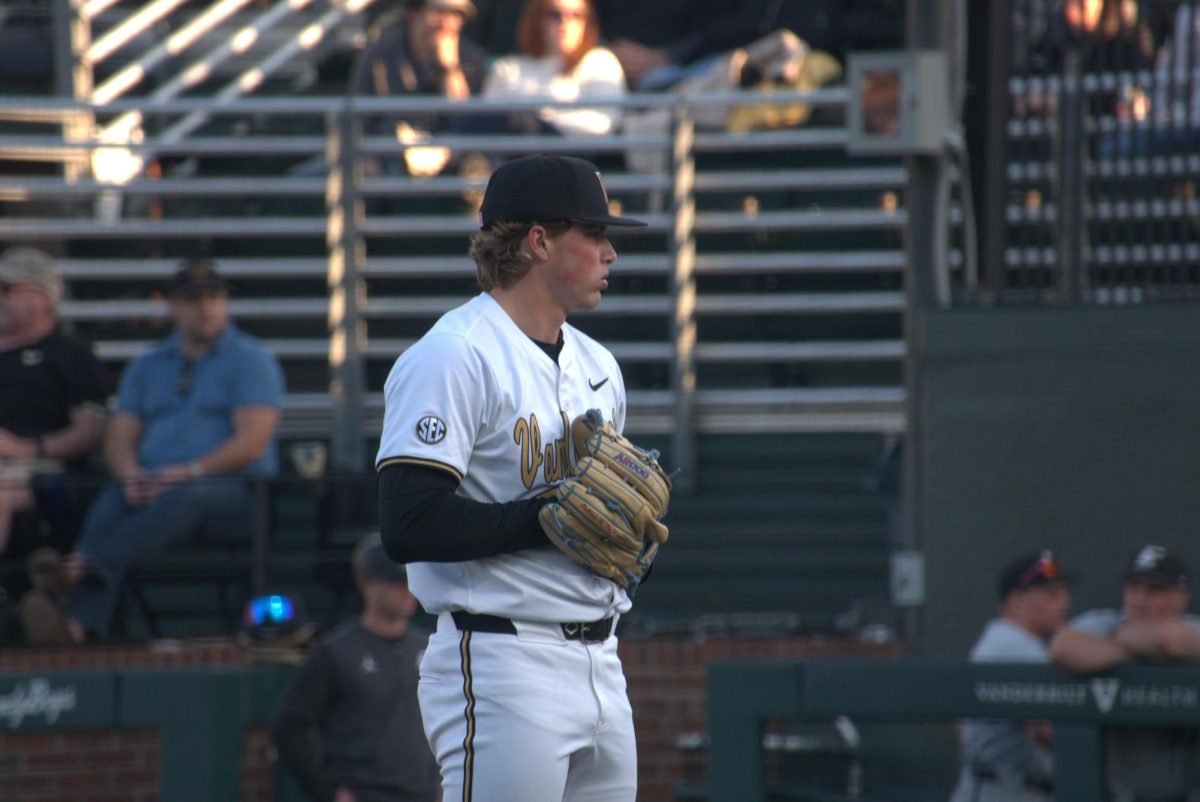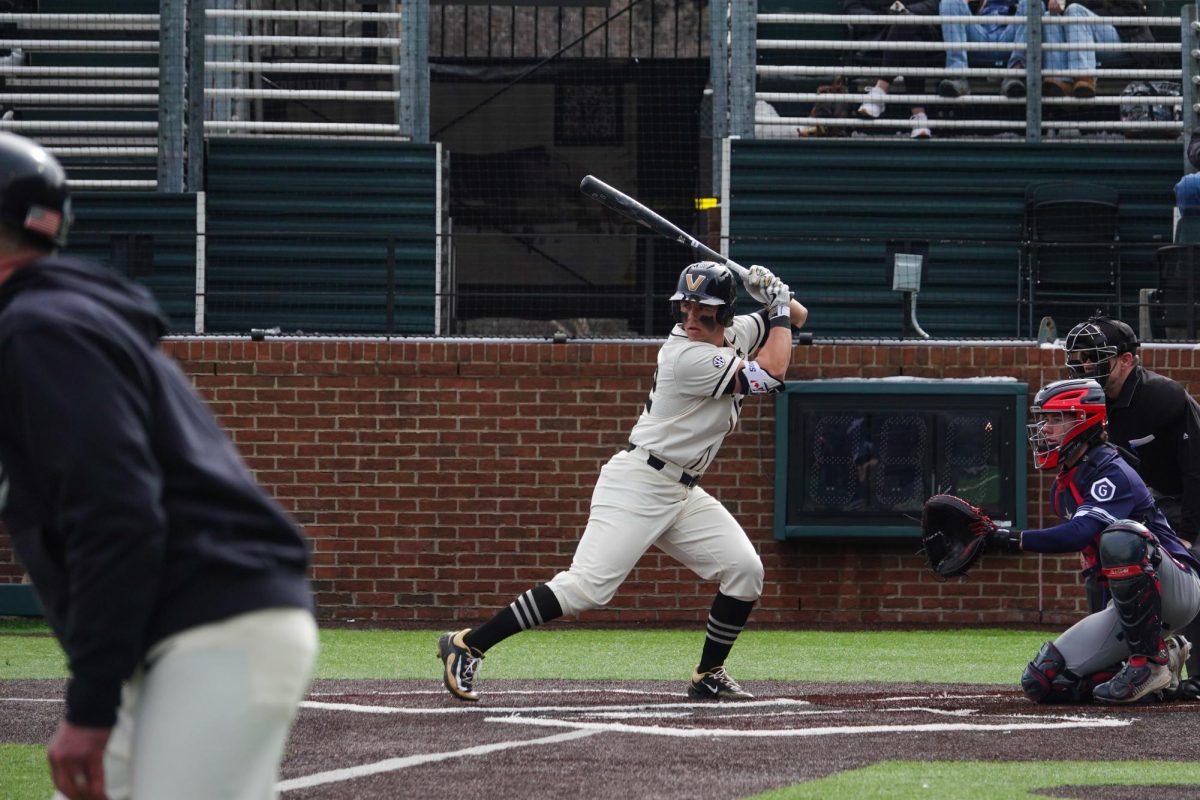The No. 4 Vanderbilt Commodores continued their winning ways with a series victory over No. 6 South Carolina. Vanderbilt has now won all seven of its traditional weekend series this year and ― with a 13-2 conference record ― sits a full two games ahead of the rest of the SEC. As the Commodores keep on winning, here are some of the takeaways from their series against the Gamecocks.
Three up.
Taking advantage of mistakes
As much as I dislike this sort of narrative, South Carolina really lost this series as much as Vanderbilt won it, if not moreso. The Gamecocks committed an atrocious eight errors over the series, including four on Saturday. Nine of the 20 total runs Vanderbilt scored over the weekend were unearned. If all the plays that should have been made were made on defense, South Carolina probably would have won this series. In fact, it might have even been a sweep.
With that said, taking advantage of mistakes is a skill in and of itself. Tim Corbin’s traditional offensive style of putting the ball in play works particularly well against teams who commit errors, especially on the tricky Hawkins Field turf. That’s how Vanderbilt ended up winning a series in which it was out-homered 8-3. At the plate, South Carolina struck out 32 times compared to 24 for Vanderbilt. The Commodores have the third-fewest errors in the SEC with 24, while the Gamecocks have committed 39, the second-most. When you put these numbers together, Vanderbilt forces its opponents into situations where they would make mistakes in the field, while avoiding those mistakes itself. It’s a formula that’s worked for years and one that’s been a major part of the Commodores’ success so far.
Bullpen wins
For several reasons I’ll get into later, this was certainly not a banner weekend for Vanderbilt’s usually strong starting rotation. The starters covered only 11 of the 27 defensive innings, allowing 10 earned runs in the process. Both the Saturday and Sunday games were really won by the bullpen. Setting aside Sam Hliboki’s rough Friday, the stretched out bullpen did very well. On Saturday, Greysen Carter, Patrick Reilly and Nick Maldonado allowed no more runs for the rest of the game after Carter Holton recorded only two outs and allowed four. Better yet, all three of those pitchers went multiple innings, including four frames from Reilly. On Sunday, Ryan Ginther entered a tie game in the sixth inning with two runners on and the dangerous former Commodore Gavin Casas at the plate. He forced a quick groundout from Casas, recorded nine more outs and recorded the win. Sure the Gamecocks tacked on two more runs, but that was after Vanderbilt could afford to give them up, and Ginther saved the rest of the bullpen from potentially having to pitch a second time in the weekend.
What kind of shape the bullpen is in now is another question. They did just have to cover 16 innings (21 if you include frequent reliever Bryce Cunningham) ahead of a dangerous midweek against regular Regional contender Indiana State and next weekend’s trip to Tennessee. The pitching situation for those games is a little more questionable, and Corbin acknowledged as much.
“You just do what you have to do,” Corbin said in Sunday’s postgame presser. “We’ll just use the guys that we have. We might spread them out. Guys who don’t pitch as much are going to have to pitch, but that’s okay.”
Leadoff production from Enrique
It can sometimes be easy to focus just on middle-of-the-order power hitters when analyzing an offense and miss how important guys like Enrique Bradfield Jr. are. The lead-off man was 4-for-10 this weekend with four more walks, a homer and five runs scored. He’s the team leader in runs scored (49), walks (39) and, of course, stolen bases (26).
In the more recent years of baseball analytics that emphasize power above all else, those three figures sometimes don’t receive the respect they deserve. Bradfield Jr.’s uncanny ability to find a way to reach first base ― and then inevitably second base ― is essential to the Commodores’ success. Nearly every time the junior outfielder gets on, all of Davis Diaz’s gappers in the two-spot score a run. RJ Schreck’s homers count for two. Even a couple of ground balls placed in the right spot can plate runs with his speed. In what is likely Bradfield Jr.’s final year in the Black and Gold, his pivotal role in the team should be really appreciated.
Three down.
Keep it in the park
In our preview of this series, Luke Rollfinke warned of how dangerous South Carolina’s bats are. Their eight home runs this weekend added to their lead over the rest of the SEC in that metric (86). The majority of the damage came in Friday’s 14-6 loss, in which the Gamecocks left the park five times. Catcher Cole Mesina had two of those homers, while freshman phenom Ethan Petry had one during game one and another one on Sunday. Of course, it’s important that those homers are solo shots.
Vanderbilt’s pitching staff has typically been very good about stopping the long ball and limiting the damage when it does go out. The Commodores’ 34 home runs allowed are fifth-lowest in the SEC. Playing in a pitchers’ park with as good a staff as Vanderbilt has, this weekend is probably just a product of one particularly bad day against a strong lineup.
Pitching injury questions
Exacerbating the strain on Corbin and Scott Brown’s bullpen is an increasingly worrying list of injuries and missed or short starts. Typical Saturday starter Hunter Owen missed his outing this week, while returning ace Holton only made two outs. Meanwhile, freshman Andrew Dutkanych IV is still out with a lower-body issue, but is expected to return soon. Corbin said that Holton is back to full health, and Owen’s injury was initially dismissed as “fatigue.” With that information, it is likely that both starters and Dutkanych will be back soon, possibly even for Tennessee. As usual, Corbin has been opaque when discussing these situations, so it’s hard to know exactly what the problems are and who will be back when. With that said, the staff is deep enough that those starters’ absence has not really cost them much yet. Furthermore, there is no midweek after the Tennessee series during finals week, so the staff will have some extra time to recover then.
Umpire communication
Plenty has already been said and tweeted about this already, but I want to say one more point about the play that ended the fifth inning on Saturday and the need for improved communication between umpires and fans.
In case you missed it, here’s a quick summary of what happened in this bizarre play. With the bases loaded, one out and the score tied 4-4, RJ Austin hit a fly ball to the warning track in left-center field. South Carolina center-fielder Evan Stone jumped to make the catch at the wall, bobbled the ball and caught it falling down. It was not clear whether the ball hit his glove initially for a catch or hit the wall. Bradfield Jr. tagged up from third base and scored. Meanwhile, the Gamecocks threw the ball into the infield, tagged several bases and the runners, and everyone else was called safe. Clearly, none of the runners knew where they were supposed to go. The umpires subsequently huddled for a full ten minutes, conversing several times with both head coaches before eventually the Gamecocks ran off the field to a chorus of boos.
The scoreboard initially showed a score of 5-4, different from the 4-4 score on TV and in the live stats broadcast. The run then came off the scoreboard before being added back on a few minutes later. The explanation we received eventually was that the ball was not caught, Bradfield Jr.’s run did count, Schreck was forced out at third and Austin was called out after abandoning first base. To make matters more confusing, both Schreck and Corbin then gave different explanations of what they were told in their postgame press conferences, neither of which was consistent with the one we initially received.
I do not mean to single out this one umpire crew because these sorts of plays happen all the time. What does concern me is the disconnect between what was called on the field and what the fans knew. SEC umpires already wear microphones to communicate replay decisions with the fans in the stadium and the TV broadcast. If that system is already available, it should also be used to communicate these kinds of plays: What the call is and why. This communication gap is a big problem in both professional and college baseball, and it’s tremendously frustrating to fans who have to watch for twenty minutes without knowing what the score even is. For a sport that is growing as fast as it is, college baseball should take this real step to make itself easier to follow for its fans.
The VandyBoys will return on Tuesday, April 18 for their midweek against Indiana State at 6 p.m. CDT at Hawkins Field.

